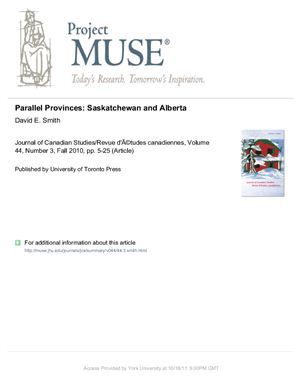Joual of Canadian Studies/Revue d'?tudes canadiennes (December
2010), 44 (3), pg. 5-25
Published by University of Toronto Press
Abstract:
The thesis that Canada's original major political parties were also the principal entities that bound the federation together is a well-explored subject. Over the last four decades, the disappearance of any political party in Canada that can convincingly claim to perform that function arguably throws into doubt the utility of the thesis. In the present article, and focussing once again on the political evolution of Saskatchewan and Alberta, the author re-examines the case he earlier advanced for the pre-eminence of political parties as fundamental institutions for the maintenance of Canada's unity. He argues that this analysis gave inadequate attention to the structures and practices of federalism, an oversight that has grown more evident in light of the strains that have accompanied recent developments in federal-provincial relations, in particular between the centre and the "twin" provinces created by Parliament in 1905.
R?sum?:
La th?se affirmant que les principaux partis politiques originaux du Canada ?taient ?galement les principales entit?s liant la f?d?ration ensemble est un sujet bien couvert. Au cours des quatre dei?res d?cennies, la disparition de tout parti politique au Canada d?clarant avec conviction remplir cette fonction pourrait mettre en doute l'utilit? de cette th?se. Dans le pr?sent article, l'auteur r?examine le cas qu'il avait pr?sent? pr?c?demment conceant la pro?minence des partis politiques en tant qu'institutions fondamentales pour la pr?servation de l'unit? canadienne, en mettant de nouveau l'accent sur l'?volution politique de la Saskatchewan et de l'Alberta. Il avance que cette analyse n'a pas accord? assez d'attention aux structures et pratiques du f?d?ralisme, une lacune qui est devenue de plus en plus ?vidente en observant les difficult?s qui ont accompagn? les r?cents d?veloppements dans les relations f?d?rales-provinciales – en particulier entre le centre et les provinces « jumelles » cr??es par le Parlement en 1905.
Published by University of Toronto Press
Abstract:
The thesis that Canada's original major political parties were also the principal entities that bound the federation together is a well-explored subject. Over the last four decades, the disappearance of any political party in Canada that can convincingly claim to perform that function arguably throws into doubt the utility of the thesis. In the present article, and focussing once again on the political evolution of Saskatchewan and Alberta, the author re-examines the case he earlier advanced for the pre-eminence of political parties as fundamental institutions for the maintenance of Canada's unity. He argues that this analysis gave inadequate attention to the structures and practices of federalism, an oversight that has grown more evident in light of the strains that have accompanied recent developments in federal-provincial relations, in particular between the centre and the "twin" provinces created by Parliament in 1905.
R?sum?:
La th?se affirmant que les principaux partis politiques originaux du Canada ?taient ?galement les principales entit?s liant la f?d?ration ensemble est un sujet bien couvert. Au cours des quatre dei?res d?cennies, la disparition de tout parti politique au Canada d?clarant avec conviction remplir cette fonction pourrait mettre en doute l'utilit? de cette th?se. Dans le pr?sent article, l'auteur r?examine le cas qu'il avait pr?sent? pr?c?demment conceant la pro?minence des partis politiques en tant qu'institutions fondamentales pour la pr?servation de l'unit? canadienne, en mettant de nouveau l'accent sur l'?volution politique de la Saskatchewan et de l'Alberta. Il avance que cette analyse n'a pas accord? assez d'attention aux structures et pratiques du f?d?ralisme, une lacune qui est devenue de plus en plus ?vidente en observant les difficult?s qui ont accompagn? les r?cents d?veloppements dans les relations f?d?rales-provinciales – en particulier entre le centre et les provinces « jumelles » cr??es par le Parlement en 1905.

